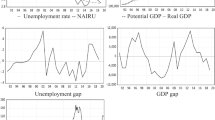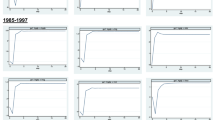Abstract
Nigeria adopted the Structural Adjustment Programme (SAP) in 1986 after the crash in world oil price in the early 1980s. Financial reforms are part of the reforms implemented during the SAP. Since industrialisation is seen as an engine of growth, we conduct an empirical assessment of the effects of financial sector reforms on industrialisation in Nigeria using an annual time series data over 1981–2015. Using an autoregressive distributed lag model, our findings show that financial reforms have a positive and significant impact on industrialisation.

Source: Based on underlining data from PCA analysis
Similar content being viewed by others
Notes
Other reforms implemented include trade reforms and exchange rate reforms.
Bulk of the literature on the impact of financial liberalisation in developing countries focused on economic with little on industrialisation. This paper extends the study on the impact of financial liberalisation by examining its impact on industrialisation.
The final score for this dimension involved the use of the weight of two subsections (see Abiad et al. 2010, p. 296 for details).
The method used in the study was found to be highly correlated with the other two methods. The correlation coefficient is higher than 95% for both measures.
The study period started in 1981 and not 1987 when financial reforms started. Our decision was informed by two factors: first, the need to have a relatively large sample size that is sufficient for econometric analysis, and second, the need to incorporate pre and post reform period. This is important because the measure of financial reforms used in the study captures gradual implementation of the reform. Hence, there is need to combine periods before the implementation as well as periods after commencement of the reforms, while the ending date (2015) was informed by data available.
Detailed information on financial reforms in Nigeria has been explained and can be found in “Construction of financial reform index” section.
References
Abiad A, Detragiache E, Tressel T (2010) A new database of financial reforms. IMF Staff Pap 57:281–302
Adeleye N, Osabuohien E, Bowale E, Matthew O, Oduntan E (2018) Financial reforms and credit growth in Nigeria: empirical insight from ARDL and ECM techniques. Int Rev Appl Econ 32(6):807–820
Akinlo AE (1996) The impact of adjustment programme on manufacturing industries in Nigeria, 1986–1991: a sample study. Afr Dev Rev 8:61–96
Andersen TB, Tarp F (2003) Financial liberalization, financial development and economic growth in LDCs. J Int Dev J Dev Stud Assoc 15(2):189–209
Bahmani-Oskooee M, Oyolola M (2007) Export growth and output growth: an application of bounds testing approach. J Econ Finance 31(1):1–11
Bandiera O, Caprio G, Honohan P, Schiantarelli F (2000) Does financial reform raise or reduce saving? Rev Econ Stat 82(2):239–263
Batuo ME, Asongu SA (2015) The impact of liberalisation policies on income inequality in African countries. J Econ Stud 42(1):68–100
Burhop C (2006) Did banks cause the German industrialization? Explor Econ Hist 43:39–63
Chenery HB (1955) The role of industrialization in development programs. Am Econ Rev 45:40–57
Chete LN, Adeote JO, Adeyinka FM, Ogundele O (2014) Industrial development and growth in Nigeria: lessons and challenges. WIDER working paper, no. 2014/019
Chow PCY (1987) Causality between export growth and industrial development empirical evidence from the NICS. J Dev Econ 26:55–63
Da Rin M, Hellmann T (2002) Banks as a catalysts for industrialization. J Financ Intermed 11:366–397
Engle RF, Granger CWJ (1987) Co-Integration and error correction: representation, estimation, and testing. Econometrica 55(2):251–276
Folarin OE, Asongu SA (2017) Financial liberalization and long-run stability of money demand in Nigeria. African Governance and Development Institute working paper no. 17/018, Yaoundé
Fowowe B (2008) New estimates of the effect of financial liberalisation on economic growth in Nigeria. Sav Dev 32:205–225
Fowowe B (2013) Financial liberalization in Sub-Saharan African: what do we know? J Econ Surv 27:1–37
Gibson HD, Tsakalatos E (1994) The scope and limits of financial liberalisation in developing countries. J Dev Stud 30(3):578–628
Gui-Diby SL, Renard MO (2015) Foreign direct investment inflows and the industrialization of African countries. World Dev 74:43–57
Harris R, Sollis R (2003) Applied time series modelling and forecasting. Wiley, Hoboken
Jerome A, Ogunkola EO (2004) Foreign direct investment in Nigeria: magnitude, direction and prospects. African Economic Research Consortium Special Seminar Series, Nairobi
Jolliffe IT (2002) Principal component analysis, 2nd edn. Springer, New York
Kabango GP, Paloni A (2011) Financial liberalization and the industrial response: concentration and entry in Malawi. World Dev 39:1771–1783
Khanna S (1999) Financial reforms and industrial sector in India. Econ Polit Wkly 34(45):3231–3241
Kouame WA, Tapsoba SJA (2018) Structural reforms and firms’ productivity from developing countries. IMF working paper no. WP/18/63
Laeven L (2003) Does financial liberalization reduce financing constraints? Financ Manag 32(1):5–34
Levine R (1997) Financial development and economic growth: views and agenda. J Econ Lit 35(2):688–726
McKinnon RI (1973) Money and capital in economic development. The Brookings Institution, Washington, DC
Ministry of Budget and National Planning (2017) Federal Republic of Nigeria, economic recovery and growth plan: 2017–2010. Ministry of Budget and National Planning, Abuja
Murphy KM, Shleifer A, Vishny RW (1989) Income distribution, market size, and industrialization. Q J Econ 104:537–564
Ng S, Perron P (2001) Lag length selection and the construction of unit root tests with good size and power. Econometrica 69:1519–1554
Owusu EL, Odhiambo NM (2014) Financial liberalisation and economic growth in Nigeria: an ARDL-bounds testing approach. J Econ Policy Reform 17(2):164–177
Pesaran MH, Shin Y, Smith RJ (2001) Bounds testing approaches to the analysis of level relationships. J Appl Econ 16:289–326
Rajan R, Zingales L (1998) Financial dependence and growth. Am Econ Rev 88(3):559–586
Rodrik D (2007) Industrial development: some stylized facts and policy directions. In: Industrial development for the 21st century. U.N. Department of Economic and Social Affairs, Division for Sustainable Development
Rowthorn R, Ramaswamy R (1999) Growth, trade and deindustrialization. IMF Staff Pap 46:18–41
Shaw ES (1973) Financial deepening in economic development. Oxford University Press, New York
Shrestha MB, Chowdhury K (2006) Financial liberalization index for Nepal. Int J Appl Econ Quant Stud 3(1):41–54
Singh A (1997) Financial liberalisation, stock markets and economic development. Econ J 107(Ma):771–782
Stiglitz JE, Weiss A (1981) Credit rationing in markets with imperfect information. Am Econ Rev 71(3):393–410
Szirmai A (2012) Industrialisation as an engine of growth in developing countries 1950–2005. Struct Change Econ Dyn 23:406–420
Tchamyou VS (2017) The role of knowledge economy in African business. J Knowl Econ 8(4):1189–1228
UNECA (2011) Industrial policies for the structural transformation of African economies: options and best practices. Policy research paper no. 2. United Nations Economic Commission for Africa (UNECA), Addis Ababa
UNECA (2013) Making the most of Africa’s commodities: Industrializing for growth, jobs, and economic transformation. United Nations Economic Commission for Africa (UNECA), Addis Ababa
UNIDO (2013) Industrial development report 2013. Sustaining employment growth: the role of manufacturing and structural change. UNIDO, Vienna
Weiss J (2018) Lewis on industrialisation and industrial policy. J Int Dev 30(1):61–79
Wells H, Thirlwall AP (2003) Testing Kaldor’s growth laws across the countries of Africa. Afr Dev Rev 15:89–105
World Bank (2016) World development indicators. World Bank, Washington, DC. http://databank.worldbank.org/data/download/WDI_excel.zip. Accessed 22 April 2017
Acknowledgements
The author is indebted to the editor and the reviewers for insightful comments. Also, the author wishes to thank Babajide Fowowe, Oluwatosin Adeniyi, Simplice Asongu, Abimbola Oyinlola and Ekpeno Effiong for their inputs in strengthening the quality of this paper.
Author information
Authors and Affiliations
Corresponding author
Additional information
Publisher's Note
Springer Nature remains neutral with regard to jurisdictional claims in published maps and institutional affiliations.
Rights and permissions
About this article
Cite this article
Folarin, O.E. Financial reforms and industrialisation: evidence from Nigeria. J. Soc. Econ. Dev. 21, 166–189 (2019). https://doi.org/10.1007/s40847-019-00075-z
Published:
Issue Date:
DOI: https://doi.org/10.1007/s40847-019-00075-z




